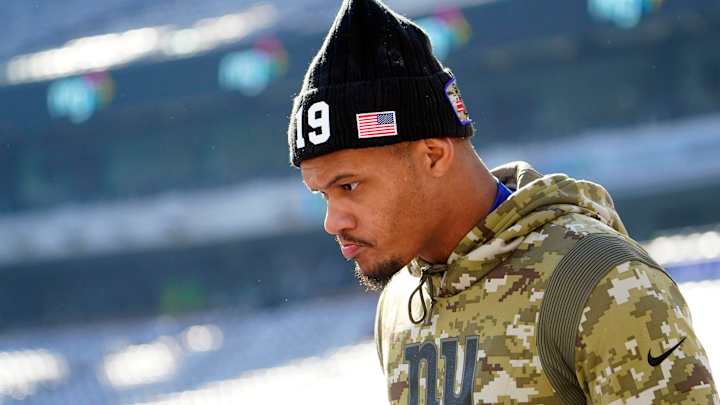Why Two Proposed Kenny Golladay Trades Don't Make Sense

Trade receiver Kenny Golladay?
That’s the suggestion of Bleacher Report’s Ian Wharton, who suggested at least one trade every NFL team should make before training camp.
Wharton actually proposed two trades involving the Giants’ No. 1 receiver, the first being a swap with the Ravens for tight end Nick Boyle and a 2023 sixth-round draft pick.
Wrote Wharton of this proposed scenario:
The New York Giants are the only team not considered a playoff contender among the five teams with the least cap space available. Stuck with several large contracts until next offseason, the Giants should be as concerned with dumping long-term money as acquiring new talent. Since the Giants can’t afford a major acquisition that fits their timeline, the best they can do is trade Kenny Golladay.
Golladay failed to click with quarterback Daniel Jones in 2021 after signing as a free agent from Detroit. Maybe his hip injury from 2020 lingered into 2021, but a lack of chemistry and consistency were concerning. He produced just 521 yards on 37 receptions.
Finding a new home for Golladay is complicated by the fact that his new team would need to pay his $13 million base salary in 2022. Baltimore would need to reshuffle some money to make this work, but it has a need for a playmaking receiver after dealing Marquise Brown during the NFL draft. Golladay would give Lamar Jackson a trustworthy, big-bodied threat who can win on deep jump balls better than anyone on the roster.
It's no secret that people were frustrated by the lack of chemistry with Jones and production Golladay had last year. But a strong argument can be made linking all that to the injuries that sabotaged any chemistry he had built up with Jones in their first spring together.
When speaking about the offense at the start of last year, Golladay expressed trepidation about whether the unit would be able to hit the ground running, a prophecy that unfortunately came to fruition.
Couple that with the flaws of the scheme run by then-offensive coordinator Jason Garrett in which Golladay was targeted 74 times (16.6 percent) out of 382 routes run with only 14 deep targets and nine in the red zone, and in retrospect, the Giants' offense, with or without Golladay was doomed.
Golladay didn't help his cause. But how much of it resulted from his injuries is a valid question.
Defenders gave Golladay an average of 5.4 yards of cushion--the ninth most allowed to receivers. Yet Golladay averaged just 1.2 yards of separation, 95th among receivers.
On the flip side, an argument can certainly be made that the Giants, desperate to surround Jones with playmakers, overpaid for Golladay, who was coming off a season-ending hip ailment during his final season with the Lions.
The Giants’ former brass, in what remains to this day a head-scratching move, did a 180-degree turn in their approach to free agency in 2021, doing everything the opposite of what they had done in 2020.
This included signing free agents that were coming off major (and recent) injuries to big-money deals in 2021 as opposed to the approach they took in 2020 when they signed up-and-coming, injury-free talents ready for a second contract to reasonable deals.
That being said, the financials probably wouldn’t work for the Ravens even if this proposed trade made sense—and it doesn’t for many of the same reasons why trading Saquon Barkley at this juncture doesn’t make sense.
The Ravens, per Over the Cap, have $6.682 million in cap space. If they unloaded Boyle, they would only save $1.12 million according to OTC and have to eat $3.315 million in dead money this year and $3.315 million in dead money next year.
Add the cap savings of $1.12 million that the Ravens would save to their projected cap space total, and Baltimore wouldn’t even have enough to fit Golladay, who is due a guaranteed $13 million in base salary, under their current cap unless the Giants agreed to pay some of that base salary (that in addition to the $4.5 million roster bonus they already paid Golladay).
Even if the Ravens were to restructure what’s left of Golladay’s contract, they’d have to ensure his 2022 figure matched that $13 million. Any money they converted to a signing bonus would swell Golladay’s numbers considerably. That could, in turn, make it tricky for the Ravens to re-sign some of their key players unless they were to trim some fat off their 2023 cap.
In his second proposed trade involving Golladay, Wharton has the receiver going to the Bears for a 2023 sixth-round pick, noting:
No team has more cap room over the 2023 and 2024 seasons than the Chicago Bears. This team is ripe for an upside swing on a talented but expensive player who didn’t work out elsewhere. The best marriage between fit, team need, and an expendable player is wide receiver Kenny Golladay.
The New York Giants’ star free-agent signing from the 2021 offseason struggled mightily in his first season with the franchise. The offense was ravaged by injuries, and Golladay’s effort level was questionable. A new regime might buy Golladay another year in the Big Apple, but the Giants should pounce if given the chance to shed his massive $21.15 million cap hit.
Because of the way Golladay’s contract is structured, New York will save $17.75 million in cap space if they deal him. Chicago would assume just $13 million in salary in 2022. They could cut him after the season and incur a modest $3.4 million dead-cap hit from 2023 through 2025 if he simply doesn’t work out.
The best case for Chicago is Golladay flourishes with Justin Fields. Fields is a tremendous downfield passer, but the Bears lack an explosive big body who can get downfield. A receiving room with Golladay, Darnell Mooney, Velus Jones, and Byron Pringle would stand a chance of helping Fields make a leap this season.
Besides the fact that the Giants wouldn't totally shed themselves of Golladay's $21.15 million cap hit, this trade makes no sense for several reasons, including the value the Giants would be getting in return for a receiver with a couple of 1,000-yard campaigns under his belt and who has been one of the better receivers in the league at making contested catches when healthy.
If the Giants made this trade, they’d save $17.75 million but would be hit with $3.4 million in dead money in 2022. The following year, the $10.2 balance of Golladay’s’ prorated signing bonus—which, to get it as low as possible, the Giants tacked on a voidable year as part of the original contract’s structure—would hit the 2023 cap.
That’s a large chunk of change for the Giants, whom Over the Cap estimates will have $54.364 million in space next year, to absorb when they might have to re-sign their quarterback and lead running back.
And if that’s not enough to convince you, that $10+ million could go a long way toward signing the 2023 draft class.
Can the salary cap be manipulated? Yes, but as we saw with the Giants’ attempt to manipulate it during the 2021 off-season, too much manipulation can lead to cap hell.
One gets the sense that this regime, as led by general manager Joe Schoen, would much rather play it safe with the cap and use other mechanisms to create space on the back end of contracts.
Join the Giants Country Community
- Sign up for our FREE digest newsletter
- Follow and like us on Facebook
- Submit your questions for our mailbag
- Listen and subscribe to the daily LockedOn Giants podcast.
- Subscribe and like the new LockedOn Giants YouTube Channel
- Sign up for our FREE message board forums
